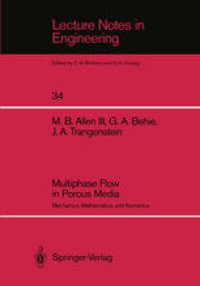
Ebook: Multiphase Flow in Porous Media: Mechanics, Mathematics, and Numerics
- Tags: Mineral Resources, Appl.Mathematics/Computational Methods of Engineering, Mechanics
- Series: Lecture Notes in Engineering 34
- Year: 1988
- Publisher: Springer-Verlag New York
- Edition: 1
- Language: English
- pdf
The past decade has seen remarkable growth in research related to petroleum reseIVoir simulation. This growth reflects several developments, not the least of which is the increased interest in oil recovery technologies requiring sophisticated engineer ing. Augmenting this interest has been the broader availability of supercomputers capable of handling the tremendous computational demands of a typical reseIVoir simulator. The field of reseIVoir simulation incorporates several major facets of applied mathematics. First, in view of the varieyt and complexity of the processes encoun tered, it is imperative that the modeler adopt a systematic approach to establishing the equations governing reseIVoir flows. Second, the mathematical structure of these flow equations needs to be carefully analyzed in order to develop appropriate and efficient numerical methods for their solution. Third, since some aspects of the discretized flow equations are typically stiff, one must develop efficient schemes for solving large sparse systems of linear equations. This monograph has three parts, each devoted to one of these three aspects of reseIVoir modeling. The text grew out of a set of lectures presented by the authors in the autumn of 1986 at the IBM Scientific Center in Bergen, Norway. We feel that it is only appropriate to caution the reader that many of the ideas that we present in this monograph do not reflect standard approaches in petroleum reseIVoir simulation. In fact, our aim is to outline promising new ways of attacking reseIVoir simulation prob lems, rather than to compile another textbook for the mainstream.
This book addresses three important aspects of modeling petroleum reservoirs. The first aspect is the development of governing equations from physical principles. The second is the analysis of the mathematical structure of the governing equations and the development of numerical methods for their solution. This part of the book examines incompressible flow problems to motivate an analysis of the standard black-oil model. The discussion compares numerical methods from other fields to the most common methods used in petroleum engineering. The third aspect is the construction of algorithms for the solution of the resulting large linear systems on digital computers. The purpose of the monograph is to introduce new and emerging viewpoints on several difficult problems in petroleum reservoir modeling, with special relevance to enhanced oil recovery technologies. The book is aimed at engineers and applied mathematicians having some familiarity with the basics of petroleum engineering, advanced engineering mathematics, and numerical methods.
This book addresses three important aspects of modeling petroleum reservoirs. The first aspect is the development of governing equations from physical principles. The second is the analysis of the mathematical structure of the governing equations and the development of numerical methods for their solution. This part of the book examines incompressible flow problems to motivate an analysis of the standard black-oil model. The discussion compares numerical methods from other fields to the most common methods used in petroleum engineering. The third aspect is the construction of algorithms for the solution of the resulting large linear systems on digital computers. The purpose of the monograph is to introduce new and emerging viewpoints on several difficult problems in petroleum reservoir modeling, with special relevance to enhanced oil recovery technologies. The book is aimed at engineers and applied mathematicians having some familiarity with the basics of petroleum engineering, advanced engineering mathematics, and numerical methods.
Content:
Front Matter....Pages I-IV
Basic Mechanics of Oil Reservoir Flows....Pages 1-86
Numerical Analysis of Reservoir Fluid Flow....Pages 87-246
Numerical Linear Algebra for Reservoir Simulation....Pages 247-306
Back Matter....Pages 308-308
This book addresses three important aspects of modeling petroleum reservoirs. The first aspect is the development of governing equations from physical principles. The second is the analysis of the mathematical structure of the governing equations and the development of numerical methods for their solution. This part of the book examines incompressible flow problems to motivate an analysis of the standard black-oil model. The discussion compares numerical methods from other fields to the most common methods used in petroleum engineering. The third aspect is the construction of algorithms for the solution of the resulting large linear systems on digital computers. The purpose of the monograph is to introduce new and emerging viewpoints on several difficult problems in petroleum reservoir modeling, with special relevance to enhanced oil recovery technologies. The book is aimed at engineers and applied mathematicians having some familiarity with the basics of petroleum engineering, advanced engineering mathematics, and numerical methods.
Content:
Front Matter....Pages I-IV
Basic Mechanics of Oil Reservoir Flows....Pages 1-86
Numerical Analysis of Reservoir Fluid Flow....Pages 87-246
Numerical Linear Algebra for Reservoir Simulation....Pages 247-306
Back Matter....Pages 308-308
....